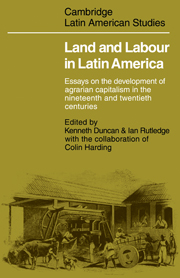 Land and Labour in Latin America
Land and Labour in Latin America Published online by Cambridge University Press: 07 May 2010
David Brading's paper constitutes the essential introduction to Part I, since it provides a useful point of departure for examining the development of the hacienda system. The haciendas of the Bajio of Mexico exemplify the economic and social difficulties encountered by pre-capitalist cereal agriculture – low profitability, unstable market conditions, and above all an underlying tension between the demands of demesne cultivation and the encroachments of tenant fanning. Indeed, in the particular case studied by Brading it seems that the landowning class had practically lost this struggle even before the great Mexican agrarian revolution of 1910–17. Jan Bazant's paper takes a similar starting point, showing the conflict between large landowners and the various categories of tenant labour settled on the periphery of their estates. However, in the haciendas of San Luis Potosí, unlike the Bajío, during the latter part of the nineteenth century the landowners were relatively successful in gradually restricting the rights of their tenants and successfully converting their peones into an increasingly impoverished class of day-wage labourers, stripped of the meagre privileges and security of the pre-capitalist agrarian society.
Arnold Bauer and Ann Hagerman Johnson deal in considerable detail with the changes in land tenure and land use during the period of expanding cereal agriculture in Chile. They show that the extension of cultivation took place mainly within the boundaries of existing estates through the conversion of previously unused land, and that there was in fact little or no change in the actual pattern of land ownership. (A similar point is made by Juan Martinez Alier in his paper on the Peruvian highlands.)
To save this book to your Kindle, first ensure [email protected] is added to your Approved Personal Document E-mail List under your Personal Document Settings on the Manage Your Content and Devices page of your Amazon account. Then enter the ‘name’ part of your Kindle email address below. Find out more about saving to your Kindle.
Note you can select to save to either the @free.kindle.com or @kindle.com variations. ‘@free.kindle.com’ emails are free but can only be saved to your device when it is connected to wi-fi. ‘@kindle.com’ emails can be delivered even when you are not connected to wi-fi, but note that service fees apply.
Find out more about the Kindle Personal Document Service.
To save content items to your account, please confirm that you agree to abide by our usage policies. If this is the first time you use this feature, you will be asked to authorise Cambridge Core to connect with your account. Find out more about saving content to Dropbox.
To save content items to your account, please confirm that you agree to abide by our usage policies. If this is the first time you use this feature, you will be asked to authorise Cambridge Core to connect with your account. Find out more about saving content to Google Drive.